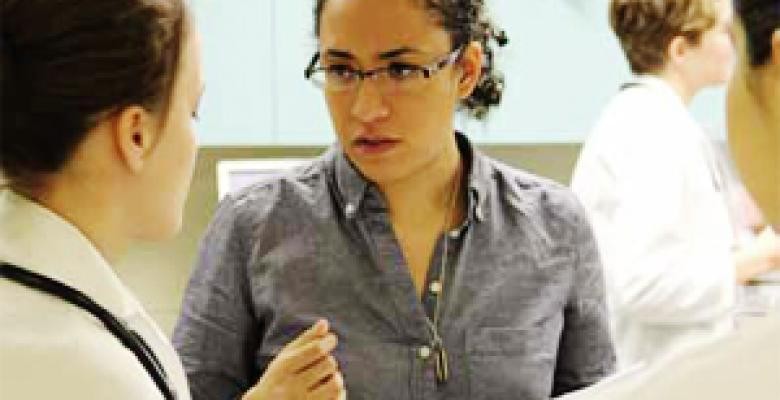Medical Student Helps Build Bridges to Neighboring Community

When she started medical school four years ago Camila Mateo felt an immediate connection to the neighborhood surrounding the College of Physicians and Surgeons. The language, the culture and the food were familiar to the daughter of two Dominican-born pediatricians. Her paternal grandmother even lived on 175th Street and worked in a zipper factory in the 1960s. “I feel more at home in Washington Heights than anywhere else I’ve lived,” says Mateo, 26, who grew up in Boca Raton, Fla.
Early in her first year at Columbia, Mateo volunteered as an interpreter for Columbia Students Medical Outreach, which runs a community-based clinic for the uninsured. She later began seeing patients in the clinic under the supervision of volunteer doctors. In her last year, she created a website to help others at the medical school better understand the community around them.
“I had all this insight into my patients’ lives that most of my classmates don’t have,” says Mateo, who spoke Spanish at home and until starting medical school visited the Dominican Republic once or twice a year. Her classmates grew frustrated, for example, when patients disappeared for months and didn’t return for follow-up visits. Mateo knew why. “The Dominican culture is very transnational,” she says. “Many are supporting families there. They have businesses there. They may have children there. They go back and forth.”
Her website, VIDA, or Virtual Introduction to Dominican Americans in Washington Heights and Inwood (www.vida.wikischolars.columbia.edu) was begun as a scholarly project, fulfilling a new graduation requirement that began with the class of ’13, and whose aim is to have students explore an area of medical practice or research.
VIDA is chock-full of information about the neighborhood around the medical center, its history, culture and demographics—about three quarters of residents are Latino, most of them Dominicans. The website delves into the health issues facing local residents and facts about the Dominican diet and the use of home remedies. There’s even a section on local restaurants and historical sites.
Mateo got advice about online platforms from Columbia’s Center for New Media Teaching and Learning, visited various community organizations, asked other students for their questions and wrote all the text herself. Meanwhile, she found time to sing, play guitar, banjo and ukelele with a small band of medical students at the P&S Club in Bard Hall.
Since VIDA went live, she has met with faculty members to encourage them to integrate it in the medical school curriculum. She also wants it to be available to newly admitted students before they arrive in New York. “It’s important to know the people you’re treating,” she says. “Cultural competency improves your ability to be a better doctor.” Her first patient when she began a clinical rotation in pediatrics was a 3-year-old with a rare neurological condition causing facial paralysis who was suffering from aspirational pneumonia. The child’s large Dominican family, none of whom spoke English, filled the hospital room, and Mateo served as their bridge to the medical team. She remembers their hugs when the child was discharged.
Mateo, who has a B.S. in health sciences from the University of Florida, has wanted to be a doctor since she was a child, inspired by her parents and the satisfaction they derived from their work. Her parents, grandmothers, aunt and her younger brother who is a second-year medical student at George Washington University, are all coming to see her get her M.D. In addition to her diploma, Mateo is receiving this year's Harry S. Altman Prize, which is given for outstanding achievement in pediatric care. She also will be inducted into the Physicians & Surgeons Gold Humanism Honor Society, which honors students who practice medicine with empathy and and ppay close attention to their patients' personal experience.
This summer she begins a residency in pediatrics, with a concentration in urban health and advocacy, at Boston's Children's Hospital and Boston Medical Center. But she says she will miss New York City and Columbia, which pushed her to be the best physician she can be but also let her be herself. "It's something all medical schools should do," she says.